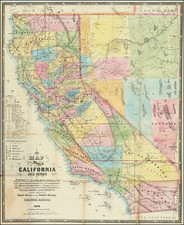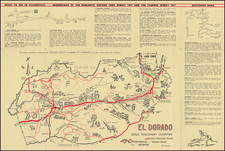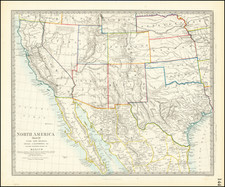Rare Early California Oil Company Prospectus.
With a map of the Santa Barbara area.
First edition of Prof. Benjamin Silliman Jr.'s second report on oil in California, with the large folding map of Santa Barbara. This important work stands as one of the earliest promotional works for a California oil company, thus marking the beginning of the oil industry in the region. Petroleum exploration by other companies in Southern California quickly followed the efforts of the California Petroleum Company. Silliman's first report was issued in 1864, but was not issued with the map. The present prospectus, often referred to as Silliman's second report, and issued by Francis & Loutrel, is the first edition to include the folding map. The map locates the company's lands around Ojai in Santa Barbara County. This work also contains one folding cross-section: The ideal section from Buenaventura to Mupu Arroyo.
As noted in the Heckrotte Catalog:
This rare little prospectus discusses all aspects of extracting petroleum, a recent source of wealth in the Santa Barbara area. Includes a paragraph on labor (discussing Chinamen who were industrious but faced a backlash), plus discussions on the market for oil and much on geology, and of course the proposed earnings for those investing in the company. The folding map is "Map Representing Locality of the Ojai Ranch in Santa Barbara County, California, belonging to the California Petroleum Company" (58x39 cm). The map shows the coast from Pt. Concepcion to San Pedro Bay at a scale of 6 miles to an inch. Ranchos are shown. It has an inset of the Ojai Basin. The folding diagram shows an "Ideal Section from Buenaventura to Mupu Arroyo." Warren Heckrotte comments that "This the second pamphlet and the second by Silliman dealing with oil in California; and the map is regarded as the first to show oil deposits in California. (However, Doolittle's map of Humboldt County, 1865 also shows gas and oil deposits.) The text states that the map was prepared by Thomas Sprague, Surveyor of Santa Barbara County. The text states that the oil outcrops are numbered on the map, but this is not the case."
In addition to detailing the oil lands, the map covers an area in what is now Ventura County and indicates the names of various ranches in the region. Streeter notes that the map is on an unusually large scale of 6 miles to the inch.
The map includes an index to properties and an inset Map of the basin of Ojai: compiled from surveys made by G.H. Thompson, U.S. Dep. Surveyor, by J.H. Wildes, principal draftsman to U.S. Sur. Genl., California.
The California Petroleum Company was capitalized at $10,000,000 and issued 100,000 shares at $100 each, with one-tenth of the capital stock reserved for working capital. The text details methods used in processing petroleum and suggests its future importance as a fuel, as a replacement for coal, and as an application in the manufacture of illuminating gas. Silliman, who was a noted chemistry professor at Yale, concludes that:
...the promise of a remarkable development at Buenaventura is far better than it was in the Pennsylvania or Ohio regions - since so famous.
Despite Silliman's glowing report his findings were attacked by Josiah Whitney and William Brewer - largely based on some early samples of doubtful quality. While the California Petroleum Company did not survive the ensuing controversy, Silliman was ultimately vindicated in his understanding of the rich potential of the petroleum deposits of Southern California.
An important and rare work for the California oil industry, described by the Eberstadts as the beginning of the petroleum industry in the West.
Benjamin Silliman Jr. (1816-1885) was a significant figure in 19th-century American science, renowned for his contributions to chemistry and geology, notably in the burgeoning field of petroleum science. The son of a famed chemist and professor at Yale College, Benjamin Silliman Sr., he followed in his father's footsteps and carved out his own distinguished academic and scientific career. Graduating from Yale in 1837, he later became a professor of chemistry at the same institution, where he was instrumental in developing its scientific curriculum and facilities.
Silliman Jr. is perhaps best remembered for his pioneering work in the oil and petroleum industries in the United States. His analytical skills were showcased in 1855 when he conducted one of the first scientific studies of crude oil. Commissioned by the Pennsylvania Rock Oil Company, his work provided a comprehensive chemical analysis of petroleum and helped stimulate the first American oil boom by highlighting oil's potential uses in illumination and lubrication. His report became a cornerstone in the development of the petroleum industry, demonstrating the economic viability of rock oil.
Aside from his scientific pursuits, Silliman Jr. also made notable contributions to the popularization of science through his editorship of the American Journal of Science, founded by his father. His efforts in science education and communication, coupled with his pioneering studies in petroleum, cemented his legacy as a key figure in American science during a period of rapid industrial and technological transformation.

![[ California Petroleum ] A Description of the Recently Discovered Petroleum Region in California. With a Report on the Same [with:] Map Representing Locality of The Ojai Ranch in Santa Barbara County, California, belonging to the California Petroleum Company 1865 By Benjamin Silliman, Jr.](https://storage.googleapis.com/raremaps/img/small/103844.jpg)











![The Marseilles Hymn. In French & English. Marche des Marseillois [First American edition of the Marseillaise and 30 other mostly American music sheets from the late 18th century and early 19th century]](https://storage.googleapis.com/raremaps/img/small/73106.jpg)



![[ Southern & Central California Yokuts ] The Southern and Central Yokuts](https://storage.googleapis.com/raremaps/img/small/103201.jpg)